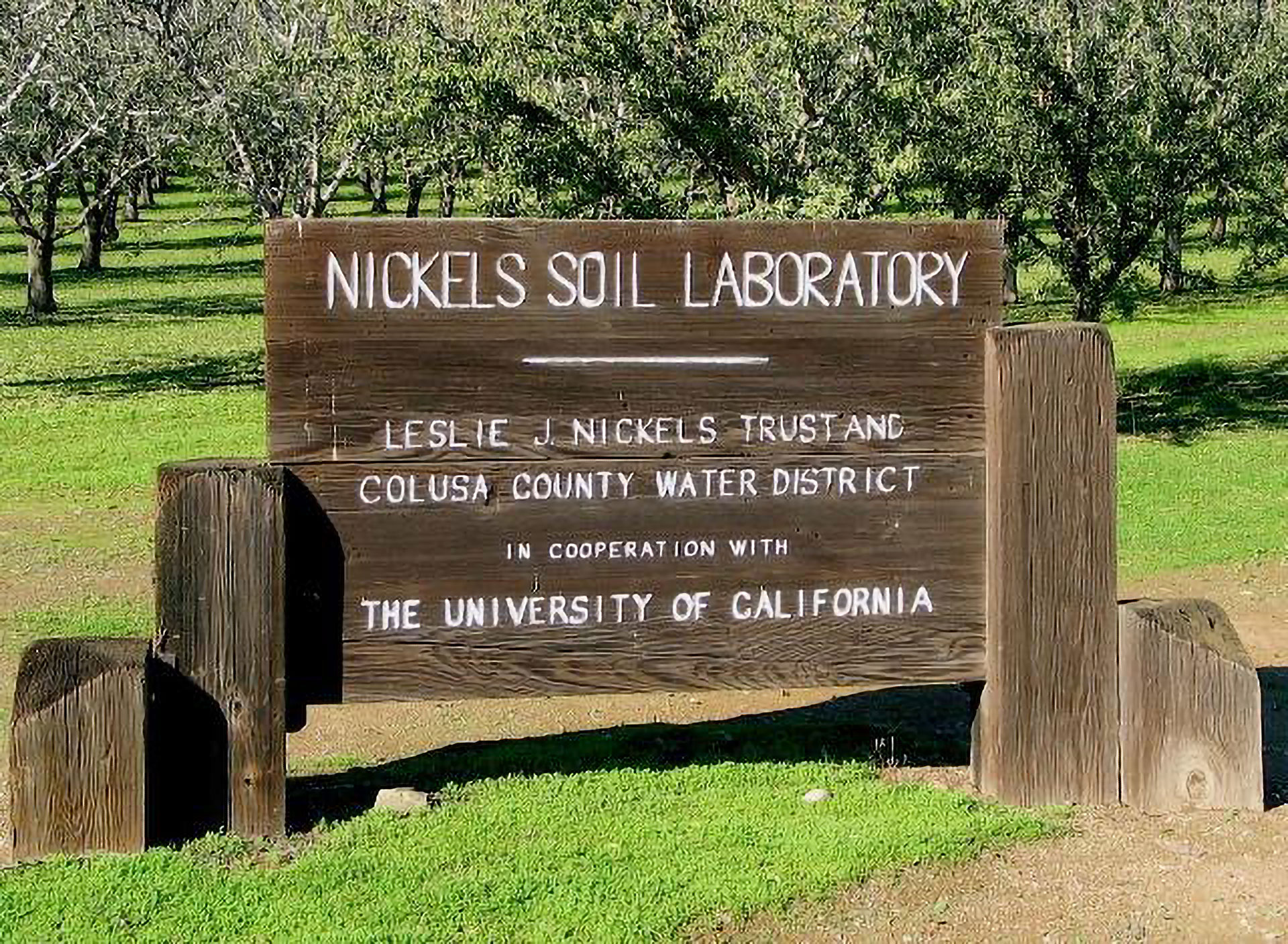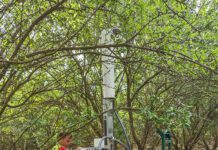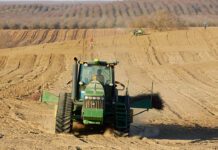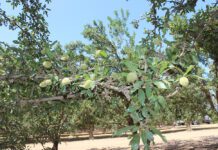Loss of the annual Nickels Soil Lab Field Day this year due to COVID-19 restrictions meant California tree nut growers missed an opportunity to hear valuable updates and see demonstrations of the research being conducted there by University of California farm advisors, University of California and USDA researchers and graduate students.
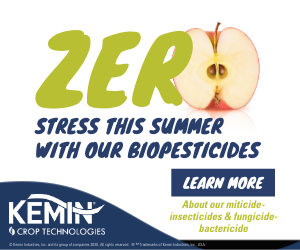
The Nickels Soil Lab (NSL), located 5 miles SW of the town of Arbuckle in Colusa County, is the largest almond research site in the United States. It is a private facility owned by The Leslie J. Nickels Trust and managed in coordination with UC Cooperative Extension since 1982 with support from the Colusa County Water District . The purpose of the NSL is to benefit the agriculture community by conducting research to improve production with an emphasis on soil and irrigation technologies. The facility has 110 acres of almonds, 17 acres of walnuts, three acres of olives and 55 plus acres of unplanted ground (open fields and shop/equipment yard). The almond acreage includes parcels managed with certified organic materials and practices.
Franz Niederholzer, NSL research coordinator and UCCE area orchard systems advisor in Colusa, Yuba and Sutter counties, said there are 15 research or demonstration projects in progress at the lab this year. Management techniques for marginal soils, irrigation practices trials, pruning, pest and disease management, variety and rootstock trials, and orchard systems trials have yielded valuable information for the tree nut industry. The following trials are a sample of the work being done at Nickels.
Evaluating Tree Row Spacing
One trial initiated in 2017 is evaluating the influence of almond tree row spacing on orchard health and production. Niederholzer emphasized that this 16-acre trial is similar to a much larger one conducted in the Modesto area since 2000 by UCCE farm advisor Roger Duncan. The Nickels trial was done to determine if similar tree spacing results to those Duncan found would be replicated in a different growing region.
The Nickels trial, conducted by Niederholzer, Stan Cutter and Bruce Lampinen, compares the economic sustainability of four tree spacings—12 feet, 14 feet, 16 feet and 18 feet down the row. The trial included two different rootstocks of different vigor, Titan peach/almond hybrid and Rootpac-R®, an almond/plum hybrid. All plantings were 50 percent Nonpareil, 25 percent Aldrich and 25 percent Kester.
The first Nonpareil/Titan harvest was in 2019. There were no significant yield differences between the four spacing treatments. Pounds per acre ranged from 403 in the 12-foot spacing to 355 pounds per acre in the 18-foot spacing and may have been limited by the poor bloom weather that year. There were significant differences in trunk diameter averaged across the tree spacing in each block showing the soil variability across this planting. Titan rooted trees on 12-foot spacings had smaller trunk circumference than those on the wider spacings, while there was no difference in trunk circumferences between the Rootpac-R tree spacings.
Remote Valve Control System
AN ABC-funded study of a remote valve control system and precision irrigation scheme for multi variety almond orchards was conducted at Nickels by Kelley Drechsler, a PhD student in Dr. Isaya Kisekka’s lab at UC Davis. The aim of this trial was to establish an automated precision irrigation system capable of remotely irrigating almond trees by variety. The work also sought to evaluate regulated deficit irrigation in Nonpareil, Butte and Aldrich varieties in the period from hullsplit initiation to harvest and quantify effects on total yield, nut quality and water efficiency. A cost analysis of the effects of modifying the irrigation system was included.
After one season, no significant differences were found in kernel yield or kernel count. Delaying RDI until Butte hullsplit initiated was associated with a reduction in percent sealed shells compared to implementing RDI according to Nonpareil hullsplit timing.
The team found that the remote system was a convenient option for implementing RDI in multiple varieties. The trial also concluded that in-line pressure sensors and soil moisture sensors are critical in producing a reliable remote irrigation control system. Treatments are being repeated this year. Cost of using a remote valve control system will also be compared to cost of a conventional system.
Rootstock Study
An alternate almond rootstock study, planted in 2006 by John Edstrom, Stan Cutter and Gerry Hernandez, showed yield differences between Nonpareil scions grafted or budded on eight rootstocks. The peach/almond hybrid (Nickels) rootstock and Nonpareil combination was the highest yielding combination.
Of special interest to the almond industry is the performance of Nonpareil on Krymsk 86, a peach/plum hybrid. The trial summary reported this selection has become the primary almond rootstock in the Sacramento Valley due to excellent anchorage and tolerance of heavier soils along with Nonpareil compatibility. Another new plum rootstock in the trial is the Empryrean 2, which shows good vigor with Nonpareil compared to Lovell.
The summary also noted that leaf chloride levels appear to be recovering from effects of the drought years. Use of irrigation water with moderate levels of chloride and boron during the drought in addition to less leaching from wither rains, produced elevated chloride levels in some, but not all rootstocks, primarily the Lovell and Krymsk 86 rooted trees.
Comparing Self-Fertile Yields
In January 2013, a replicated experiment was planted to assess nut yield potential and gross income per acre for self-fertile (Independence) and the self-incompatible traditional Nonpareil, Aldrich and Sonora varieties. Spacing (15’ x 20’) and rootstock (Viking) was the same for all trees at 145 trees per acre.
Cumulative yield between the two orchard systems is not significantly different after five harvests according to the summary by Niederholzer, Cutter, Bobby Johnson, Luke Milliron and Drew Wolter. There were differences from year to year. The trial summary reports that in 2019, Sonora and Nonpareil produced significantly more yield per acre than the Independence and Aldrich. The yield patterns were the opposite in 2018, when a week of freezing temperatures at bloom reduced yield in Nonpareil and Sonora varieties, but not the Independence or Aldrich.
Gross income per acre in 2019 was higher for the Nonpareil plus pollinizers than the 100 percent self-fertile based on the following prices: $2.75 per pound in-shell for Nonpareil and Sonora, $2.60 for Independence and $2.16/pound for Aldrich . The summary noted that the income does not include potential savings with single variety due to reduced pollination costs and reduced harvest costs.
Almond Variety Group Trial
An almond variety group trial by Edstrom, Cutter and Niederholzer sought to evaluate the overall productivity and suitability of three different groups of pollinizer varieties with 50% Nonpareil. Trees were planted in 2006 with north to south row orientation at 16-foot tree spacing and 22-foot row spacing on Lovell peach seedling rootstock with double-line drip irrigation. Groups: 1. 50 percent Nonpareil, 25 percent Fritz, 25 percent Monterey; 2. 50 percent Nonpareil, 25 percent Winters, 25 percent Aldrich; 3. 50 percent Nonpareil, 25 percent Winters, 25 percent Monterey.
Nonpareil yield was not influenced by pollinizer varieties used in this trial. A review of cumulative yield per acre for each variety showed significant differences early in the life of the orchard, but as of 2019, cumulative yield was not significantly different between all varieties and pollinizer groups. The report noted there were significant differences in average yield by block from east to west, so the yield differed more with the landscape than with the varieties in many years.
Organic Production Trial
For the past 14 years, organic versus conventional almond management practices have been compared on a 7-acre orchard of Nonpareil and Fritz varieties planted on Lovell peach seedling rootstock. The trial team of Edstrom, Cutter, Niederholzer, Bill Krueger and Lampinen reported that the most challenging issues have been nitrogen fertility, weed control and disease management.
Organic fertilizer has been applied via irrigation system, but 2019 summer leaf analysis showed that trees were nitrogen deficient. Weed cloth barriers and propane flaming were used to prevent weeds in the orchard, although the weed cloth was abandoned in 2012 due to mower/weed cloth problems. In 2007, subsurface drip was instilled and has proven to reduce costs for weed control. Leaf rust is being controlled with sulfur sprays ahead of forecast rain. This practice has had the biggest impact on organic production over the last six seasons.
The report attributes sanitation and early harvest for the less than one percent NOW damage in Nonpareil. The Fritz variety, harvested Oct. 1 had 4.5 percent damage in field samples. Recommendation to growers planning an organic orchard is to consider earlier harvesting varieties.
Summaries of Nickels Soil Lab trials not included in this article can be obtained from Niederholzer at fjniederholzer@ucanr.edu.


